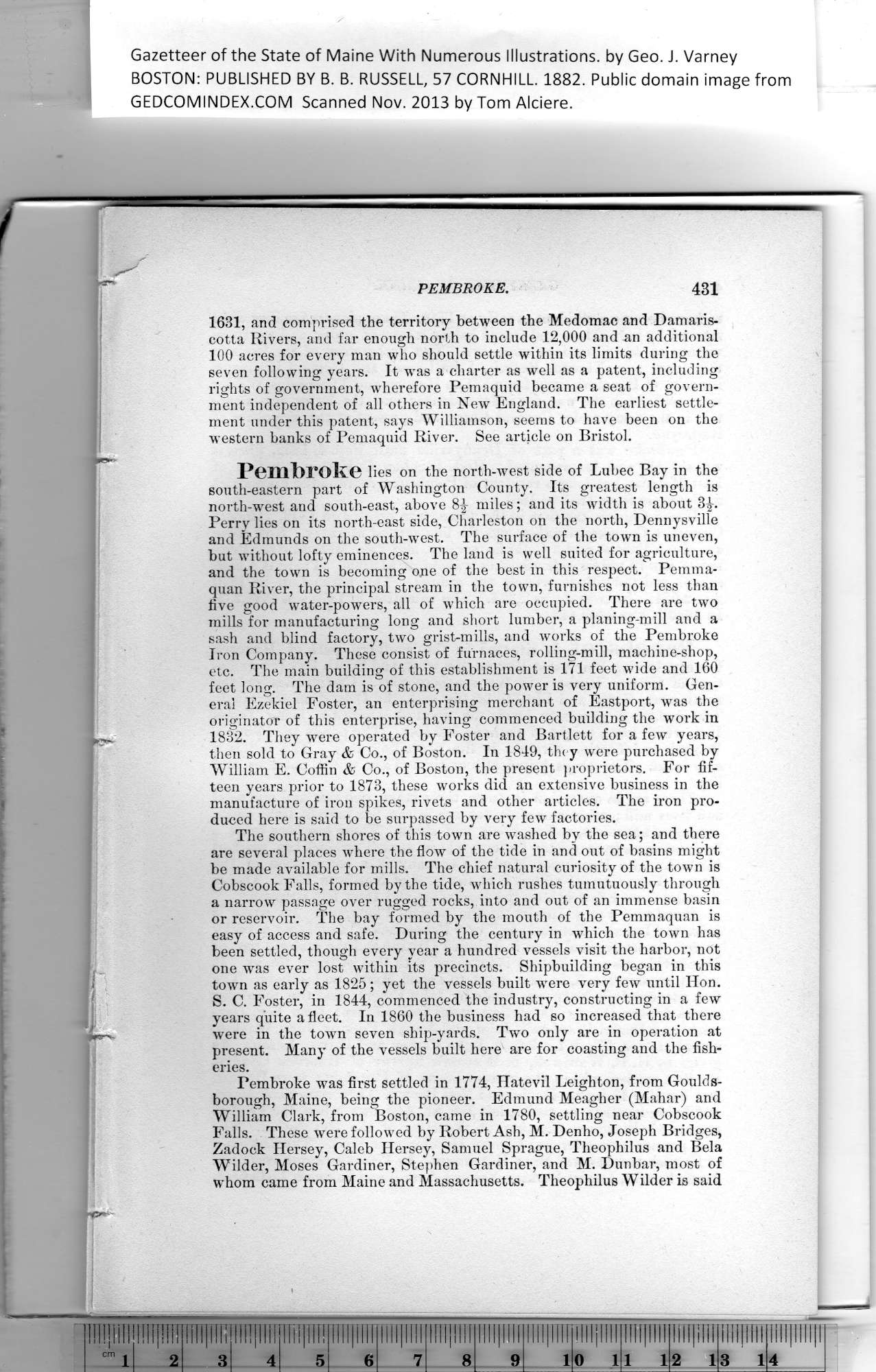|
Gazetteer of the State of Maine With Numerous Illustrations, by Geo. J. Varney
BOSTON: PUBLISHED BY B. B. RUSSELL, 57 CORNHILL. 1882. Public domain image from
PEMBROKE.
1631, and compi-ised the territory between the Medomac and Damaris-
cotta Rivers, and far enough north to include 12,000 and an additional
100 acres for every man who should settle within its limits during the
seven following years. It was a charter as well as a patent, including
rights of government, wherefore Pemaquid became a seat of govern-
ment independent of all others in New England. The earliest settle-
ment under this patent, says Williamson, seems to have been on the
western banks of Pemaquid River. See article on Bristol.
Pembroke lies on the north-west side of Lubec Bay in the
south-eastern part of Washington County. Its greatest length is
north-west and south-east, above 84 miles; and its width is about 3£.
Perry lies on its north-east side, Charleston on the north, Dennysville
and Edmunds on the south-west. The surface of the town is uneven,
but without lofty eminences. The land is well suited for agriculture,
and the town is becoming one of the best in this respect. Pemma-
quan River, the principal stream in the town, furnishes not less than
five good water-powers, all of which are occupied. There are two
mills for manufacturing long and short lumber, a planing-mill aud a
sash and blind factory, two grist-mills, and works of the Pembroke
Iron Company. These consist of furnaces, rolling-mill, machine-shop,
etc. The main building of this establishment is 171 feet wide and 160
feet long. The dam is of stone, and the power is very uniform. Gen-
eral Ezekiel Foster, an enterprising merchant of Eastport, was the
originator of this enterprise, having commenced building tbe work in
1832. They were operated by Foster and Bartlett for a few years,
then sold to Gray & Co., of Boston. In 1849, they were purchased by
William E. Coffin & Co., of Boston, the present proprietors. For fif-
teen years prior to 1873, these works did an extensive business in the
manufacture of iron spikes, rivets and other articles. The iron pro-
duced here is said to be surpassed by very few factories.
The southern shores of this town are washed by the sea; and tbere
are several places where the flow of tbe tide in and out of basins might
be made available for mills. The chief natural curiosity of tbe town is
Cobscook Falls, formed by tbe tide, which rushes tumutuously through
a narrow passage over rugged rocks, into and out of an immense basin
or reservoir. The bay formed by the mouth of the Pemmaquan is
easy of access and safe. During the century in wbich the town lias
been settled, though every year a hundred vessels visit the harbor, not
one was ever lost within its precincts. Shipbuilding began in this
town as early as 1825; yet the vessels built were very few until Hon.
S. C. Foster, in 1844, commenced the industry, constructing in a few
years quite a fleet. In 1860 the business had so increased that there
were in the town seven ship-yards. Twm only are in operation at
present. Many of the vessels built here are for coasting and the fish-
eries.
Pembroke was first settled in 1774, Hatevil Leighton, from Goulds-
borough, Maine, being tbe pioneer. Edmund Meagher (Mahar) and
William Clark, from Boston, came in 1780, settling near Cobscook
Falls. These were followed by Robert Ash, M. Denho, Joseph Bridges,
Zadock Hersey, Caleb Hersey, Samuel Sprague, Theophilus and Bela
Wilder, Moses Gardiner, Stephen Gardiner, and M. Dunbar, most of
whom came from Maine and Massachusetts. Theophilus Wilder is said
PREVIOUS PAGE ... NEXT PAGE
This page was written in HTML using a program written in Python 3.2
|
